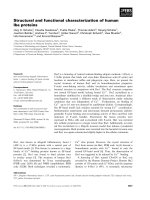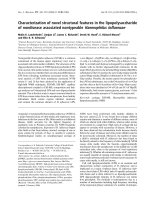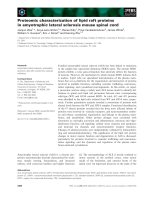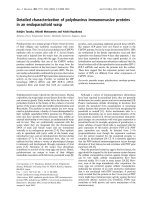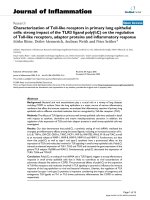Characterization of the function of tight junction proteins in transgenic mice
Bạn đang xem bản rút gọn của tài liệu. Xem và tải ngay bản đầy đủ của tài liệu tại đây (9.9 MB, 173 trang )
1
CHARACTERIZATION OF THE FUNCTION OF TIGHT
JUNCTION PROTEINS IN TRANSGENIC MICE
Xu Jianliang
INSTITUTE OF MOLECULAR AND CELL BIOLOGY
NATIONAL UNIVERSITY OF SINGAPORE
2008
2
ACKNOWLEGMENTS
I would like to express my special thanks to my supervisor, A/P Walter Hunziker, for his
patient guidance and encouragement throughout my study. I also wish to thank my
supervisory committee members, Prof. Ito Yoshiaki and Asst. Prof. Li Baojie, for their
invaluable advice and the time spent on my postgraduate committee meetings every year.
I thank Dr. Zakir Hossain for his help during the initial stages of my project, Dr. Ke Guo
for her help on the histological analysis, and Mr. Chee Peng Ng for his support with the
EM work. I thank past and present members of WH lab and other IMCB members.
3
TABLE OF CONTENTS
LIST OF FIGURES 6
LIST OF TABLES 8
LIST OF VIDEO 9
ABBREVIATIONS 10
ABSTRACT 11
CHAPTER 1: INTRODUCTION 12
1.1: Tight junctions (TJs) 14
1.1.1: Structure and function of TJs 14
1.1.2 TJ proteins 16
1.1.3 TJ modulation 18
1.2 MAGUK proteins 18
1.3 ZO proteins 20
1.3.1 ZO-1 20
1.3.1.1 Molecular structure of ZO-1 20
1.3.1.2 Expression pattern of ZO-1 21
1.3.1.3 Expression pattern of ZO-1 isoforms 22
1.3.1.4 Interaction partners 24
1.3.1.5 ZO-1 functions, regulation and associated diseases 30
1.3.2 ZO-2 34
1.3.2.1 Molecular structure of ZO-2 34
1.3.2.2 Interaction partners of ZO-2 35
1.3.2.3 ZO-2 and associated diseases 36
1.3.3 ZO-3 37
1.3.3.1 Molecular structure of ZO-3 37
1.3.3.2 Interaction partners of ZO-3 38
1.3.3.3 Functions of ZO-3 39
1.4 Rationale and aim of research 40
Chapter 2: Materials and methods 42
Chapter 3: Generation and phenotypic analysis of ZO-1 chimeric mice and embryos 51
3.1 Generation of ZO-1-/+ and -/- ES cells 51
3.2 ZO-1 chimeric mice 54
3.3 Discussion 55
Chapter 4: Generation and phenotypic analysis of ZO-2 null mice 56
4.1 Generation of ZO-2-/+ ES cells 56
4.2 Generation of ZO-2-/- mice 58
4.3 Embryonic lethality for ZO-2-/- mice 58
4.4 Decreased cell proliferation in ZO-2-/- embryos 61
4.5 Increased apoptosis in E7.5 ZO-2-/- embryos 62
4.6 ZO-2-/- embryos lack mesoderm 63
4.7 Expression and localization of TJ and adherens junction (AJ) markers is not affected
in ZO-2-/- embryos 64
4.8 The TJ architecture is altered in ZO-2-/- embryos 66
4.9 The function of TJs as a diffusion barrier is affected in ZO-2-/- embryos 66
4
4.10 ZO-2-/- blastocysts grow normally in vitro 69
4.11 Discussion 71
Chapter 5: ZO-2 rescue and phenotypic analysis 72
5.1 Expression pattern of ZO-2 in early embryo development stage 72
5.2 Generation of ZO-2 chimeric embryos 74
5.3 ZO-2 is dispensable for epiblast development 75
5.4 Chimeric expression of ZO-2-/- cells in testis results in reduced fertility of male
chimeric mice 77
5.5 Chimeric expression of ZO-2-/- cells in the testis results in apoptosis 79
5.6 ZO-2 chimeric mice present with defects in balance and hearing 82
5.7 Defects in other organs of ZO-2 chimeric mice 83
5.8 Disscusion 84
Chapter 6: Generation and phenotypic analysis of ZO-3-/- mice 86
6.1 Generation of ZO-3-/- mice 86
6.2 ZO-3-/- mice are born and viable 89
6.3 Organs of ZO-3-/- mice are histologically normal 91
6.4 Expression and localization of TJ and AJ markers are unaffected in the small intestine
of ZO-3-/- mice 92
6.5 TJ architecture is intact in ZO-3 null mice 94
6.6 ZO-3 deficiency does not affect mouse growth 95
6.7 Discussion 96
Chapter 7: Generation and phenotypic analysis of ZO-2-/-ZO-3-/- mice 97
7.1 Generation of ZO-2-/- ZO-3-/- mice 97
7.2 ZO-2-/+ZO-3 -/- mice are histologically normal 98
7.3 ZO-2-/-ZO-3-/- embryos die earlier than ZO-2-/- embryos 100
7.4 ZO-2-/- ZO-3-/- blastocysts grow normally in vitro 101
7.5 Discussion 103
Chapter 8: Phenotypic analysis of ZO-1-/- embryonic stem cells 105
8.1 Protein expression in ZO-1-/- EBs 105
8.2 The subcellular localization of several TJ and AJ markers is altered in ZO-1-/- EBs
107
8.3 The TJ structure is affected in ZO-1-/- EBs 114
8.4 ZO-1 deficiency promotes mesoderm development 116
8.5 ZO-1deficiency promotes mesoderm development via aβ–catenin/Wnt dependent
signaling pathway 116
8.6 EBs derived from ZO-1-/- ES cells have a larger volume compared to ZO-1+/+ EBs
119
8.7 Discussion 122
Chapter 9: Generation and phenotypic analysis of ZO-2-/- embryonic stem cells 125
9.1 Generation of ZO-2-/- ES cells 125
9.2 Normal expression levels of TJ and AJ markers in ZO-2-/- EBs 127
9.3 Normal localization of selected TJ and AJ markers in epithelia of ZO-2-/- EBs 129
9.4 The TJ structure and function are unaffected in ZO-2-/- EBs 133
9.5 ZO-2-/- EBs are larger as compared to that of ZO-2+/+ EBs 135
9.6 Discussion 137
Chapter 10: Generation and phenotypic analysis of ZO-1-/-ZO-2-/- ES cells 139
5
10.1 Generation of ZO-1-/-ZO-2-/- ES cells 139
10.2 Protein expression in ZO-1-/-ZO-2-/- EBs 141
10.3 The volume of ZO-1-/-ZO-2-/- EBs is larger as compared to that of WT EBs 142
10.4 ZO-1/ZO-2 double knockout affects cell attachment and migration 144
10.5 Discussion 147
Chapter 11: Generation and phenotypic analysis of ZO-2-/-ZO-3-/- embryonic stem cells
148
11.1 Isolation of ZO-3-/- ES cells 148
11.2 Generation of ZO-2-/-ZO-3-/- ES cells 151
11.3 The expression levels of TJ and AJ markers are not altered in ZO-2-/-ZO-3-/- EBs
153
11.4 The localization of TJ and AJ markers is not altered in ZO-2-/-ZO-3-/- EBs 154
11.5 Discussion 157
Chapter 12: Summary and perspectives 158
Reference 161
6
LIST OF FIGURES
Figure 1 Schematic drawing of three types of basic epithelial tissues in different organs.
Figure 2 Location and structure of TJs.
Figure 3 Schematic drawing of the TJ proteins.
Figure 4 Schematic structures of the MAGUK proteins, ZO-1, ZO-2 and ZO-3.
Figure 5 Targeting of ZO-1 locus and PCR screening.
Figure 6 Characterization of ZO-1-/- ES cell lines.
Figure 7 ZO-1 chimeric mice are embryonic lethal.
Figure 8 Targeting of the ZO-2 gene.
Figure 9 Genotyping of transgenic mice.
Figure 10 Developmental arrest of ZO-2-/- embryos.
Figure 11 Postimplantation development of ZO-2-/- embryos.
Figure 12 Cell proliferation is compromised in E6.5 ZO-2-/- embryos.
Figure 13 Enhanced apoptosis in E7.5 ZO-2-/- embryos.
Figure 14 T-gene expressions in E7.5 ZO-2-/- embryos and EBs.
Figure 15 Distribution of ZO-1and ZO-3 in ZO-2-/- embryos is not altered.
Figure 16 Apical-basal polarity is not affected in ZO-2-/- embryos.
Figure 17 The architecture of the apical junctional complex is altered in cells of ZO-2-/-
embryos.
Figure 18 The permeability barrier of the apical junctional complex is altered in cells of
ZO-2-/- embryos.
Figure 19 In vitro blastocyst culture and PCR genotyping.
Figure 20 ZO-2 expression in early stage embryos.
Figure 21 Expression of ZO-2 in the skin of E15.5 embryos.
Figure 22 Expression of ZO proteins in chimeric mice.
Figure 23 Histological analysis of the testis.
Figure 24 Apoptosis in the testis of ZO-2 chimeric mice.
Figure 25 ZO-2 and ZO-1 expression in testis
Figure 26 Targeting of the ZO-3
Figure 27 Genotyping of transgenic mice.
Figure 28 Western blot detection of ZO-3 protein.
Figure 29 ZO-3 expressions in major mouse organ.
Figure 30 H&E staining of small intestine of ZO-3-/- and ZO-3+/+ mice.
Figure 31 Protein distributions in small intestine.
Figure 32 TJ morphology
Figure 33 Postnatal growth curves of ZO-3-/- and ZO-3+/+ mice.
Figure 34 Histological analysis of ZO-2-/+ZO-3-/- mice
Figure 35 Western blots for ZO protein expression.
Figure 36 Histological analysis of ZO-2-/-ZO-3-/- embryos.
Figure 37 In vitro culture of blastocysts.
Figure 38 Statistical analysis of the number blastocysts in different genotype.
Figure 39 Expression levels of selected junction-associated proteins in ZO-1-/- EBs.
Figure 40 Distribution of ZO proteins, TJ and AJ markers in ZO-1-/- EBs.
Figure 41 Apico-basolateral polarities are not affected in ZO-1-/- EBs.
7
Figure 42 The architecture of the apical junctional complex is altered in cells of ZO-1-/-
EBs.
Figure 43 ZO-1 deficiency results in the upregulation of T-gene expression.
Figure 44 Proliferation of ZO-1-/- EBs.
Figure 45 Generation of ZO-1 -/- ES cell lines.
Figure 46 Protein expressions in ZO-2-/- EBs
Figure 47 Distribution of ZO proteins and selected TJ and AJ markers in ZO-2-/- EBs.
Figure 48 The apico-basolateral polarity is not affected in ZO-2-/- EBs.
Figure 49 The architecture and permeability barrier of the apical junctional complex are
not altered in cells of ZO-2 -/- EBs.
Figure 50 Volume of ZO-2-/- EBs.
Figure 51 Characterization of ZO-1-/-ZO-2-/- ES cells.
Figure 52 Protein expressions in ZO-1-/-ZO-2-/- EBs.
Figure 53 Morphology and cell growth curve of ZO-1-/-ZO-2-/- EBs.
Figure 54 Morphology of EBs after 2 days and 5 days culture on normal cell culture
plates.
Figure 55 Scanning electron microscopy of day (2+5) cultured EBs
Figure 56 Expression levels of ZO proteins and TJ and AJ markers in ZO-3-/- EBs.
Figure 57 ZO protein expressions in ZO-3-/- EBs.
Figure 58 Characterization of ZO-2-/-ZO-3-/- ES cells
Figure 59 Expression levels of ZO proteins and TJ and AJ markers ZO-2-/-ZO-3-/- EBs.
Figure 60 Distribution of ZO proteins, TJ and AJ markers in ZO-2-/-ZO-3 EBs.
Figure 61 Apical-basolateral polarity is not affected in ZO-2-/-ZO-3-/- EBs
8
LIST OF TABLES
Table 1 Genotypic analysis of offspring and embryos from crossing of ZO-2-/+ mice
Table 2 Statistical analysis of the frequency of TJs with altered structure in ZO-2-/- and
ZO-2+/+ embryos
Table 3 Statistical analysis of the fraction of leaky TJs in ZO-2+/+ and ZO-2-/- embryos.
Table 4 Rescue of embryonic lethality by injecting ZO-2-/- ES cell into WT blastocysts
Table 5 Cross between chimeric mice and C57BL/6 WT mice.
Table 6 Cross between different types of male mice with C57BL/6 female mice.
Table 7 Balance defect in ZO-2 chimeric mice
Table 8 Prayer Reflex analysis for hearing
Table 9 Genotypic analysis of offspring from ZO-3-/+ mice crossing
Table 10 Cross between ZO-2-/+ZO-3-/- mice does not yield any ZO-2-/-ZO-3-/- mice.
Table 11 Statistical analysis of embryo morphology (normal or small and undergoing
absorption) at E6.5 and E7.5
Table 12 Microarray analysis
9
LIST OF VIDEOS
Video: Defect in balance control of ZO-2 chimeric mice
10
Abbreviation
a.a.: amino acid
AJ: adherens junction
AMP: adenosine monophosphate
ATP: adenosine triphosphate
BBB: blood-brain barrier
BrdU:
bromodeoxyuridine
CIS: carcinoma in situ
CRC: primary colorectal cancer
CX: Connexin
EB: embryoid body
EGFR: epidermal growth factor receptor
EMT: epithelial-mesenchymal transition
ES: embryonic stem
FHC: familial hypercholanemia
GUK: guanylate-like
GMP:
guanosine monophosphate
JAM: junctional adhesion molecule
kDa: kiloDalton
MAGUK: membrane-associated guanylate kinase homolog
MDCK: Madin-Darby Canine Kidney
NES: nuclear export signal
NLS: nuclear localization signal
PATJ: PALS1-associated TJ protein
PKC: protein kinase C
PDZ: PSD-95, Dlg, ZO-1
SAF-B: scaffold attachment factor-B
SH3: Src homology 3
TER: transepithelial electrical resistance
TM: transmembrane
TJ: tight junction
ZO: Zonula Occludens
ZO-1: Zonula Occludens-1
ZO-2: Zonula Occludens-2
ZO-3: Zonula Occludens-3
ZONAB: ZO-1 associated nuclei acid binding
11
Abstract
ZO-1, ZO-2 and ZO-3 are closely related scaffolding proteins that link tight
junction (TJ) transmembrane proteins such as occludin, claudins and junctional adhesion
molecules to the actin cytoskeleton. Despite being among the first TJ proteins to have
been identified and having undergone extensive biochemical analysis, little is know about
the physiological roles of individual ZO proteins in different tissues or during vertebrate
development. Here, we show that ZO-3-/- mice lack an obvious phenotype. In contrast,
embryos deficient for ZO-2 die shortly after implantation due to an arrest in early
gastrulation. ZO-2-/- embryos show decreased proliferation at E6.5, increased apoptosis
at E7.5 and altered architecture of the apical junctional complex as compared to wild-type.
ZO-1-/- mice are currently unavailable, while chimeric mice derived from ZO-1-/-
embryonic stem (ES) cells are embryonic lethal. Because of the embryonic lethality of
the ZO-1-/- and ZO-2-/- mice, we also generated knockout ES cell lines. We have
obtained ZO-1-/-, ZO-2-/-, ZO-3-/-, ZO-1-/-ZO-2-/-, and ZO-2-/-ZO-3-/- ES cells. These
cell lines have shown various defects in their ability to differentiate into epithelial cells,
cardiomyocytes or skeletal muscle cells.
12
Chapter 1 Introduction
Multicellular organisms are separated from the external environment by a layer of
epithelial cells, which also line the internal cavities and ducts of tissues and organs.
Epithelial tissues can be grouped into three basic types: squamous (such as skin, the
linings of the peritoneum and the epidermis), cuboidal (such as the the epithelium
forming the collecting duct of the kidney), and columnar (such as that lining the small
intestine) (Figure 1). Two pathways are available for the transepithelial transport of
molecules. The first one is the transcellular pathway that requires the solutes to be
internalized to cross the epithelial cells. The second one is the paracellular pathway,
where solutes pass the paracellular barrier. Establishment of a paracellular barrier with
controlled permeability between the epithelial cells is important for the maintenance of a
specific internal environment that is crucial for the development and survival of
multicellular organisms. The epithelial cell layer is closely joined by membrane
structures named tight junctions (TJs), which play a role in allowing different tissue or
organ compartments to maintain different solute composition without, however,
completely obstructing the exchange of solutes between bordering compartments. The
permeability of TJ barrier is controlled by both internal (for example, cyclic AMP and
RhoA) and external signals (for example, zonulin antagonists and agonists), and thus can
be modulated under certain circumstances (for example, in the process EMT during
differentiation). Modulation of the TJ barrier is also of clinical interest for drug delivery.
13
Figure 1 Three types of basic epithelial tissues in different organs.
Stratified squamous epithelia form the skin; simple cuboidal epithelia line the collecting
ducts of the kidney; simple columnar cells consist of the gall bladder.
(
14
1.1 Tight junctions
1.1.1 Structure and function of TJs
TJs locate at the most apical side of two adjacent epithelial or endothelial cells
(Figure 2A). In a freeze-fracture, TJs appear as strands (Figure 2B). These strands,
derived from the two adjacent cells, form a series of fusion points, which surround each
cell on the most apical side and thus obliterate the intercellular space (Figure 2 C, D). The
major function of TJs is to seal the paracellular pathway and block the diffusion of
solutes between the external (luminal) and the internal (serosal) space. Claudins, a protein
family with over 20 members in mammals, are thought to form the charge-selective pores
in the TJ barriers. If the net charge of the pores is negative, the cations are allowed to
pass the TJ barriers (Sasaki et al., 2003). Since non-charged solutes are not affected by
the net charge in the claudins pores, they are thought to cross the TJ barriers via a
different mechanism. TJ strands are able to dynamically break and reseal and non-
charged solutes can cross TJs through the temporal gaps during this dynamic process
(Sasaki et al., 2003). The permeability of TJs varies in different tissues depending on the
functions they performed, and this is thought to reflect different claudin repertoires. For
example, the urinary bladder and the stomach duct can have a transepithelial electrical
resistance (TER) up to a few thousand Ω cm2, while the small intestine has a TER of a
few Ω cm2. The TJ permeability is not always the same even in the same organ. For
example, paracellular transport across renal tubular
epithelial TJs varies in different
segments
of the nephron.
TJs also function as a fence between apical and basolateral membrane domains to
block protein and lipid diffusion within the plasma membrane and maintain cell polarity.
15
In addition to being a permeability barrier and a fence, TJs also act as a multifunctional
complex that regulates various cellular functions such as membrane trafficking (exocyst,
rab13), signal transduction (cell density, ZO-1), tumor suppression (suppression of Ad9
E4-ORF1-induced focus formation, ZO-2), cell proliferation (ZONAB). In addtion, TJs
often serve as entry points for the infection by different pathogens (adenovirus, ZO-2).
Figure 2 Location and structure of TJs. (A) The TJ (circled) is located at the most
apical region of lateral membranes. (B) Freeze-fracture image shows the the strands
(arrowheads) and grooves (arrows) of TJs. (C) Ultrathin sectional view demonstrates
that kissiong points (arrowheads) obliterate the intercellular space in TJs. (D) Schematic
drawing of the TJs. (Tsukita et al., 2001) Mv, microvilli; TJ, tight junction; AJ, adherens
junction; DS, desmosome; AP, apical membrane; Bl, basalateral membrane
16
1.1.2 TJ proteins
In TJs, transmembrane (TM) proteins that interact with corresponding proteins on
the adjacent membranes are tethered to the actin cytoskeleton via scaffolding proteins
(Figure 3). The TM proteins are integrated in the plasma membrane and may be able to
transduce extracellular signals, for example in response to cell-cell contact, into the cells.
The scaffolding or plaque proteins locate on the cytoplasmic surface of the plasma
membrane (Figure 3). They link the integral proteins with the actin cytoskeleton. Some
plaque proteins are also involved in vesicular trafficking, nuclear shuttling, control of
gene expression and infection of viruses and bacteria. The structure and function of
selected integral and plaque proteins of TJs are discussed in more detail below.
Figure 3 Schematic drawing of the TJ proteins. TJ proteins consist of TM proteins and
plaque proteins that link TM proteins to the cytoskeleton. (Johnson LG. 2005)
17
TM proteins of TJ
The three most common TM proteins of TJs are occludin, claudins, and junctional
adhesion molecules (JAMs) (Figure 3). Both occludin and claudins have four TM regions
and two extracellular domains. Their C- and N-terminal ends reside in the cytoplasm.
Occludin is encoded by a single gene, while claudins form a large gene family of more
than twenty members in mammals. Occludin and claudins form the backbone of the TJ
strands. The combination of occludin and different members of claudins is thought to
determine the tightness of the TJs. In contrast to occludin and claudins, JAMs have only
one TM domain, with the C-terminal end locating outside the cell and the short N-
terminal tail residing inside the cytosplasm. JAMs mainly function in immune response,
involving trafficking of T-lymphocytes, neutrophiles and dentritic cells.
Plaque proteins of TJs
Plaque proteins locate under the plasma membrane and function as scaffolds to link
the TM proteins to the actin cytoskeleton (Figure 3). Plaque proteins can be grouped into
two types based on the presence (for example the ZO proteins) or absence (for example
cingulin) of one or multiple PDZ domains (González-Mariscal et al., 2007;
Guillemot et
al., 2008). The PDZ domain is a short module of 80-90 amino acids, capable of binding
small C-terminal peptide motifs or other PDZ domains. Thus, PDZ domain proteins can
function as scaffolds to bring together integral, signaling and cytoskeleton proteins. Some
scaffolding TJ proteins lacking PDZ domains such as cingulin can also link integral
proteins to the actin cytoskeleton, whereas other function in vesicular trafficking and
other cellular processes.
18
1.1.3 TJ modulation
The structure and function of TJs is dynamically regulated and this regulation is
fundamental to many physiological processes in multicellular organisms. Many cytokines
have been shown to modulate TJ function through their effects on TJ proteins and the
associated actin cytoskeleton (
Walsh et al., 2000). Small GTPases form a large family of
signal transduction molecules. They control cell-cell contact and regulate parecellular
permeability through G protein-coupled events (
Hopkins et al., 2000). In addition to
cytokines and small GTPases, protein kinase C (PKC) also plays a role in the regulation
of TJs. PKC activation dramatically increases TJ permeability and the increased leakiness
correlates with tumor promotion in epithelial cancers (
Mullin et al., 2000). Specific TJ
modulation is also of interest for therapeutic drug delivery. Drugs can cross membranes
by transcellular or paracellular pathway and the paracellular pathway is controlled by TJs.
Temporal opening of the TJs may be a promising approach for delivering therapeutic
agents (for example across the intestinal barrier) to the systemic circulation and finally to
the site of action (for example across the BBB to target the brain) (Salama et al., 2006).
1.2 MAGUK proteins
ZO-1, ZO-2 and ZO-3 are TJ associated scaffold proteins belonging to the MAGUK
(membrane-associated guanylate kinase homologs) protein family. The MAGUK proteins
are a family of proteins that locate to various junctional complexes, including TJs in the
epithelial and endothelial cells, as well as synaptic and neuromuscular junctions. They are
required for the formation of various cell junctions since loss of particular MAGUK
members may result in disruption of specific junctional complexes. For example,
19
combined ZO-1 knockout and ZO-2 knockdown completely blocks TJ formation in
epithelial cells (Umeda et al., 2006)
All MAGUK proteins have three PDZ domains, one Src homology 3 (SH3) and one
guanylatekinase-like (GUK) domain (Figure 4). As discribed above, PDZ domains bind
short C-terminal peptides or other PDZ domains. SH3 domains usually consist of 50-70
amino acids and bind ligands containing PXXP sequences or, in the case of MAGUKs,
the GUK domain. The GUK domain is homologous to the enzyme guanylate kinase,
which can catalyze the GMP at the expense of ATP. However, the GUK domain in
MAGUKs can bind neither GMP nor ATP and is thus most likely enzymatically inactive.
Figure 4 Schematic structures of the MAGUK proteins, ZO-1, ZO-2 and ZO-3. All
three members have three PDZ domains, one SH3 and one GUK domain, one C-terminal
acidic region. ZO-1 and ZO-2 have a Proline-rich region in the C-terminus, while the
Proline-rich region of ZO-3 is located between the second and third PDZ domain
(
Kausalya PJ 2005).
MAGUK proteins bind directly to the C-terminal portion of the TM proteins as well
as other signal transduction proteins and, in some cases, to actin. They function as
molecular platforms to assemble and regulate signaling pathways at the plasma
membrane and couple various extracellular signals with intracellular signal transduction
20
pathways. They also work as molecular scaffolds to maintain the structural specialization
of plasma membrane domains.
MAGUK proteins regulate the polarity of epithelial cells. Multi-domain scaffolding
proteins of the MAGUK family are widely expressed at the plasma membrane of the
polarized epithelial cells, where they participate in junction assembly, recruitment of
proteins to specific plasma membrane domains, the organization of polarized signaling
complexes and the maintenance of asymmetric proteins distributions, thus controlling
important features of cell polarity (Caruana et al., 2002).
Some MAGUK proteins can also shuttle between TJs and nucleus, where they might
be involved in the regulation of gene expression (González-Mariscal et al., 2000).
1.3 ZO proteins
1.3.1 ZO-1
1.3.1.1 Molecular structure of ZO-1
ZO-1 was the first protein shown to associate with TJs (Stevenson et al., 1986). It
has a molecular weight of 225 kDa in mouse tissues and 210 kDa in MDCK cells
(
Anderson et al., 1988). The human ZO-1 is predicted to have 1763 amino acids, with the
N-terminal 793 amino acids homologous to the Drosophila discs-large tumor suppressor
protein of septate junctions and to PSD95, a postsynaptic density protein of 95 kDa
(Willott et al., 1993). Typical for a MAGUK family member, ZO-1 has three PDZ
domains, followed by one SH3 domain and one GUK domain. In addition, ZO-1 carries
one proline-rich domain at its C-terminus (Figure 4). ZO-1 has two nuclear localization
signals (NLS), one located in the first PDZ domain and the other in the GUK domain
21
(González-Mariscal et al., 1999). ZO-1 localizes to TJs but in some cases has been
reported to be present in the nucleus in sparse cell cultures (Gottardi et al. 1996). In the
proline-rich domain, ZO-1 contains splicing variants, namely alpha, beta and gamma
(Willott et al. 1992; González-Mariscal et al. 1999). ZO-1 has two variable regions, U5
and U6. U5 locates between the SH3 and GUK domain and U6 is immediately after the
C-terminal of the GUK domain. In cultured cells, ZO-1 protein lacking U5 can not
localize to TJs, while the lack of U6 will localize ZO-1 protein to the lateral membrane,
followed by subsequent recruitment of occludin and claudins. These data indicate that the
SH3-U5-GUK-U6 region is important for protein interactions, and also for signaling
(Fanning et al. 2007).
1.3.1.2 Expression pattern of ZO-1
ZO-1 is expressed as early as in the 8-cell stage of the mouse embryo and initially
emerges as a series of punctate sites between apposed cells that subsequently punctate
and merge to form a linear belt around blastocyst trophectoderm cells. ZO-1 expression is
delayed after inhibition of cell adhesion at the 8-cell stage and its localization is disturbed
after microfilament disruption, suggesting that ZO-1 expression is dependent on cell
adhesion and cytoskeleton activity (
Fleming et al., 1989, 1991).
In adult tissues, ZO-1 is expressed in various epithelia and its expression level varies
depending on the particular tissue. For example, in kidney epithelium ZO-1 expression is
highest in glomerular epithelium and lowest in the proximal tubule (Schnabel et al.,
1990). In addition to epithelia, ZO-1 is also expressed in endothelial cells and its
expression level correlates with the cell confluence. ZO-1 expression is low in sparse cell
culture and its expression level is increased when the culture becomes confluent (Li et al.,
22
1990). Beides epithelial and endothelial cells, ZO-1 is also expressed in several non-
epithelial cell types that may or may not have typical TJs. For example, in astrocytes,
ZO-1 localizes to the cell-cell contact sites, while in S-180 cells ZO-1 is expressed at the
cell periphery and within the cytoplasm (Howarth et al., 1992). ZO-1 also distributes to
the intercalated disc of cardiomyocytes and the apposed membranes of myelinating
Schwann cells (Toyofuku et al. 1998; Poliak et al., 2002). Furthermore, ZO-1 is a major
component of the blood-testis barrier. In the testis of newborn mice, ZO-1 locates over
the apicolateral Sertoli cell membrane. After establishment of TJs, ZO-1 expression is
restricted to tight junctional regions (Byers et al., 1991). ZO-1 is also detected in human
and rat BBB. Immunostaining indicates that ZO-1 forms a banded pattern outlining
individual endothelial cells in blood vessels (Watson et al., 1991).
1.3.1.3 Expression pattern of ZO-1 isoforms
In the ZO-1 cDNA, 240-bp region is subject to alternative splicing. This exon
encodes an in-frame insertion of 80 amino acids, known as alpha motif. The skipping of
the corresponding alpha exon depends on two antagonistic exonic elements located in the
constitutive flanking exons. Depending on the presence or absence of the alpha motif,
two ZO-1 splice varients, known as ZO-1 alpha+ and ZO-1 alpha- are expressed. Both
variants are expressed in epithelial cells and localize to the TJs, while their relative
expression levels vary greatly in different cell lines. These two isoforms form hermetic
TJs but TJs become leakier when the ZO-1 alpha- is predominantly expessed (
Willott et
al.,1992;
Martínez-Contreras et al., 2003).
The expression pattern of ZO-1 alpha- and alpha+ is different during early embryo
development. ZO-1 alpha- mRNA is expressed during all pre-implantation stages, while
23
the ZO-1 alpha+ mRNA only appears at the morula stage. These two isoforms also
function differently in membrane assembly. ZO-1 alpha- initially forms punctuate sites at
the cell-cell contacts during the 8-cell stage; while ZO-1 alpha+ initially forms
perinuclear foci during the late morulae stages and joins the membrane assembly only
around the 32-cell stage. Importantly, ZO-1 alpha+ co-localizes with occludin at the
perinuclear sites in late morulae stages and at the newly assembled cell junctions. The
expression of ZO-1 alpha+ and its interaction with occludin might act as a time-limiting
step in the assembly of TJs and blastocoel formation (Sheth et al., 1997).
In animal tissues, ZO-1 alpha- is expressed in structurally dynamic junctions such as
endothelial cells, renal glomeruli and seminiferous tubules. ZO-1 alpha+ is expressed in
all other epithelial cells that are structurally less dynamic (Balda et al., 1993). Both ZO-1
alpha+ and ZO-1 alpha- are expressed in typical epithelial TJs of the kidney, while only
ZO-1 alpha- is expressed in the extremely dynamic structures such as the slit diaphragms,
where the intercellular spaces are loose, or endothelial junctions that open in response to
physiologic signals (Kurihara et al., 1992). Both ZO-1 alpha+ and alpha- are also
expressed in the testis, but their distribution varies in different locations. ZO-1 alpha+
localizes to certain TJs that join the Sertoli cells to specific classes of germ cells
(spermatogonia, preleptotene, and leptotene spermatocytes ), while ZO-1 alpha- is found
in TJs joining Sertoli cells to all classes of germ cells, suggesting that the expression of
ZO-1 isoforms might be regulated by specific Sertoli cell-germ cell contacts (
Pelletier et
al., 1997).
24
1.3.1.4 Interaction partners
Interaction partners of TJs
The first interaction partner discovered for ZO-1 was ZO-2, which was co-
immunoprecipitated with ZO-1 from MDCK cell lysates (
Gumbiner et al., 1991). ZO-1
also directly interacts with ZO-3 and co-localizes with it at the TJs in MDCK cells
(
Haskins et al., 1998). Immunoprecipitation analysis indicates that the three members of
the ZO protein family form independent ZO-1/ZO-2 and ZO-1/ZO-3 complexs rather
than a ZO-1/ZO-2/ZO-3 trimeric complex (Wittchen et al., 1999). In addition to forming
heterodimers with ZO-2 and ZO-3, ZO-1 can also form homodimers via its second PDZ
domain. Immunoprecipitation experiments indicate that a substantial fraction of ZO-1 is
present as homodimers in MDCK cells. ZO-1 homodimers and ZO-1/ZO-2 and ZO-
1/ZO-3 heterodimers might form distinct scaffolds for differnt protein networks
(Utepbergenov et al., 2006).
ZO-1 interacts with most types of TM proteins of TJs. Its association with occludin
is important for membrane localization of occludin (Furuse et al., 1994). The C-terminal
coil-coil domain of occludin dimerizes and forms a four-helix bundle that interacts with
ZO-1. The helix bundle of occludin (a.a. 406-521) interacts with the hinge region of ZO-
1 (a.a. 591-632) and ZO-1 (a.a. 726-754) in the GUK domain (Müller et al., 2005). ZO-1
interacts with claudin-1 to –8. The interaction of claudins with ZO-1 is mediated by the
C-terminal YV sequence of claudins. When claudin-1 and claudin-2 were transfected into
L fibroblasts, which only express ZO-1, all the three proteins co-localize to cell-cell
borders (Itoh et al., 1999). ZO-1 also interacts with the C-terminal TRV sequence of
Cldn16 (also known as paracellin-1/PCLN-1). Mutation of the TRV motif in Cldn16 that
25
abolishes its interaction with ZO-1, result in a predominantly lysosomal localization
(Ikari et al., 2004; Muller et al., 2003; Kausalya et al., 2006). ZO-1 can be co-
immunoprecipitated with JAM and the second and third PDZ domains of ZO-1 are
crucial for the interaction with the C-terminal PDZ-binding motif of JAM. Deletion of the
PDZ binding domain of JAM not only abolishes its interaction with ZO-1, but also
disrupts its junctional localization, indicating that ZO-1 plays a role in recruiting or
retaining JAM to intercellular junctions (Bazzoni et al., 2000; Ebnet et al., 2000).
ZO-1 also binds to cytosolic TJ plaque proteins. ZO-1 binds to the Ras-binding
domain of the Ras target AF-6 and this interaction is inhibited by activated Ras. ZO-1
and AF-6 co-localize at TJs in epithelial cells and at cell-cell adhesion sites in non-
epithelial cells. ZO-1 can be immunoprecipitated by AF-6 from Rat1 cells, indicating that
ZO-1 interacts with AF-6 in vivo (Yamamoto et al., 1999). Overexpression of activated
Ras in Rat1 cells interrupts cell-cell contacts and reduces the cell surface accumulation of
ZO-1 and AF-6, suggesting that ZO-1 may serve as an adapter protein for AF-6 to
regulate cell-cell contact formation (Yamamoto et al., 1997).
Another cytosolic TJ protein that ZO-1 interacts with is cingulin (
Cordenonsi et al.,
1999). Pull-down analysis shows that the N-terminal ZIM motif of cingulin (1-378) is
crucial for this interaction. ZO-1 can be immunoprecipitated by cingulin. However,
cingulin lacking the ZIM motif is still recruited to TJs, indicating that ZO-1 is not the
only protein that can recruit cingulin. Endogenous ZO-1 localization is disrupted in
Xenopus A6 cells overexpressing cingulin, suggesting that ZO-1 functionally interacts
with cingulin in vivo (
D'Atri et al., 2002).


